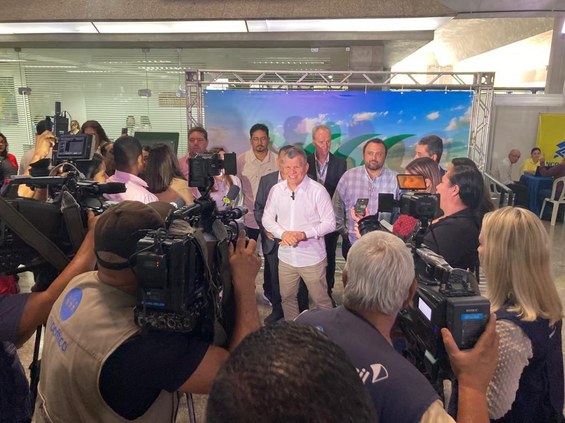Suframa and ZFM celebrate 57 years of economic, social and environmental contributions to Brazil
[ad_1]
Manaus (AM) — On February 28, 1967, the Brazilian government published Decree Law No. 288, creating Suframa and reformulating the bases of the Manaus Free Zone (ZFM) model, initially conceived as Porto Livre.
After 57 years, it is clear how Suframa and the Manaus Free Trade Zone transformed the developmental paths of the Western Amazon and Amapá, working to reduce regional inequalities, encourage sustainable development, the bioeconomy and boost the national economy, raising quality life of thousands of Brazilians.
Regulatory frameworks
Proposed in 1951 by federal deputy Francisco Pereira da Silva, the Manaus Free Zone was established in 1957 by Juscelino Kubitschek to function as a free port for the storage, processing and withdrawal of foreign products. In 1967, through Decree Law No. 288, President Castello Branco changed its nature to an industrial, commercial and agricultural center, aiming at development in the face of local challenges and distance from the main consumer centers.
In 1968, the federal government extended the benefits of the Free Zone to the Western Amazon, through Decree-Law No. 356, geographically expanding its scope. In 1975, Decree-Law No. 1,435 promoted IPI tax benefits for enterprises that invest in the industrialization of products with raw materials originating in the Western Amazon, seeking to foster economic dynamism in regions far from urban centers.
Law No. 8,387/1991 extended the development policy to the Macapá-Santana Free Trade Area, in Amapá, further expanding the regional reach of the project initiated in 1967. Furthermore, this law established counterparts for investments in Research, Development and Innovation (RD&I) for companies that produce information and communication technology goods and services with the tax incentives defined by Decree-Law No. 288/1967.
The extension of incentives, initially scheduled until 1997, occurred in 1986, 1988 and the most recent in 2014, extending the period until 2073, reflecting the importance of the ZFM for socioeconomic and environmental development, recognized nationally and internationally.
Another important milestone was the enactment of the tax reform, at the end of last year, guaranteeing the comparative advantages of the Manaus Free Zone, with the continuity of the Tax on Industrialized Products (IPI) on products competing with those manufactured in the ZFM and the creation of from the Sustainable Development Fund for the States of the Western Amazon and Amapá, reaffirming the importance of the ZFM for all of Brazil.
Importance
Throughout its history, the Manaus Free Zone has faced challenges and overcome obstacles to house one of the main industrial parks in the country. The Manaus Industrial Pole (PIM) has approximately 500 companies concentrated in the area delimited by legislation (Manaus and its surroundings), with products, mostly consumer goods that supply the Brazilian market. It is responsible for an average of 112.5 thousand direct jobs, in addition to generating jobs in other states in Brazil, whether in the sale of final goods or in the sale of inputs for industrial production.
Tax collection from PIM production places Manaus as the sixth city in Brazil – the first in the North region – with the highest fiscal contribution to the Union, according to information from IBGE.
In addition to the socioeconomic impacts that the Manaus Free Trade Zone generates, there is also an environmental gain, scientifically proven, that by concentrating economic activity in a reduced physical area, with a low rate of use of forest resources, ZFM guaranteed the preservation of 98% of the native forest of the State of Amazonas.
Suframa, as administrator of tax incentives for the Manaus Free Trade Zone, also played a crucial role in the search for regional development alternatives, investing in projects to take advantage of biodiversity and establishing partnerships with public and private institutions, both national and international. Suframa made significant investments possible throughout its area of activity, contributing to the expansion of infrastructure and specialization, master’s and doctorate educational programs in the region.
Next steps

For the superintendent of Suframa, Bosco Saraiva, the Autarchy plays a crucial role for the Amazon region and for Brazil as a whole.
“In addition to managing the Manaus Free Trade Zone, which represents a significant source of jobs, income and economic development, Suframa promotes regional integration and the internalization of economic activities, strengthening the local economy and contributing to the sustainable growth of the Western Amazon and Amapá”,
he stated.
For 2024, the superintendent highlighted the holding of the second edition of the Journey of Regional Integration and Internalization of Development in the states of Acre, Amapá, Rondônia and Roraima, throughout the year, with a focus on integration, regional development and improving the environment of businesses within the Authority’s area of activity. “There are two days of activities in which we take our teams to the States to demonstrate the agency’s performance in the region, publicize project financing opportunities and foster the research, development and innovation ecosystem”, he highlighted.
Regarding the future of ZFM after 57 years, the superintendent is optimistic, with goals of attracting more companies to the Manaus Industrial Hub and acting strongly on regional integration.
“We can expect a scenario of continuous growth, driven by the legal security guaranteed by the tax reform, which safeguarded ZFM’s differentials until 2073. This eliminates risks for companies wishing to establish themselves in the region, providing a favorable environment for investments and economic growth ”,
finished.
*With information from consultancy
Read more:
Consul of Malta visits Suframa to strengthen ties and explore investments in ZFM
Project by the ‘architect of the Amazon’, Suframa headquarters celebrates 50 years in Manaus
Suframa: President will preside over CAS meeting that will evaluate investments of R$ 1.2 billion
[ad_2]
Source link




:strip_icc()/s02.video.glbimg.com/x720/12519489.jpg)





